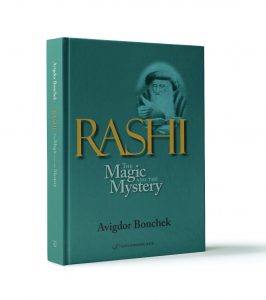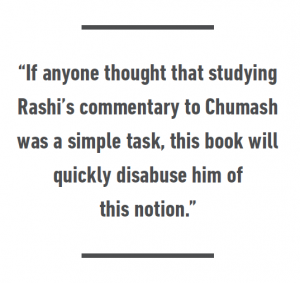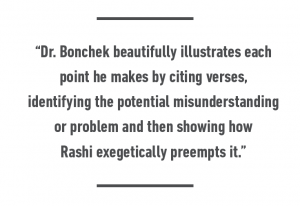Rashi: The Magic and the Mystery
 By Avigdor Bonchek
By Avigdor Bonchek
Gefen Publishing House
Jerusalem, 2015
132 pages
Reviewed by Yitzchak Etshalom
As Torah teachers, most of what we impart falls under the rubric of Torah Shebe’al Peh. When asked why so much of our tradition is dependent on an oral transmission, one of the most popular answers is that it is not only the imparting of information that is vital. In order to transmit our mesorah, we must convey the vitality of the text and the near-obsession with God’s Torah that we bring to the classroom. To wit—we must communicate a passion for learning. So much of what shapes our own attitudes towards talmud Torah is predicated on the people who taught us—our parents and our rabbeim. I still see the Rav (Rav Yosef Dov Soloveitchik, zt”l) during shiur, conducting his well-attested “symphony” of the giants of the mesorah right there in front of our eyes. That my rebbe, Rav Aharon Lichtenstein, zt”l, adored every word in the Gemara and the Rishonim that he shared was clear to anyone who merited studying with him. We continue teaching because we were taught by passionate scholars who imbued the power of their love for Torah in us in a personal and direct way.
We stress an oral tradition because it is impossible to accomplish this sort of transmission via the written word. Nonetheless, there are authors who come delightfully close and whose words reveal a love for learning and an excitement of discovery that, somehow, makes its way from the printed page (or monitor) to the heart of the student.
 Dr. Avigdor Bonchek has done just that with his recently published work on Rashi’s commentary to Chumash, Rashi: The Magic and the Mystery. It is, in a sense, a mini-culmination of Dr. Bonchek’s life avocation (he is a sought-after therapist in Jerusalem and has worked with many yeshivah and seminary programs). He published a five-volume set on Rashi’s commentary, aptly named “What’s Bothering Rashi?” To this work, he adds this slim but exciting volume, which serves to introduce the curious student to the “ins and outs” of studying Rashi. If anyone thought that studying Rashi’s commentary to Chumash was a simple task, this book will quickly disabuse him of this notion. Conversely, anyone who may have shied away from Rashi because he was under the impression that the exegete’s work was mainly that of an anthologizer of midrashim will be energized to reassess Rashi and to open up the master’s commentary with renewed interest and vigor.
Dr. Avigdor Bonchek has done just that with his recently published work on Rashi’s commentary to Chumash, Rashi: The Magic and the Mystery. It is, in a sense, a mini-culmination of Dr. Bonchek’s life avocation (he is a sought-after therapist in Jerusalem and has worked with many yeshivah and seminary programs). He published a five-volume set on Rashi’s commentary, aptly named “What’s Bothering Rashi?” To this work, he adds this slim but exciting volume, which serves to introduce the curious student to the “ins and outs” of studying Rashi. If anyone thought that studying Rashi’s commentary to Chumash was a simple task, this book will quickly disabuse him of this notion. Conversely, anyone who may have shied away from Rashi because he was under the impression that the exegete’s work was mainly that of an anthologizer of midrashim will be energized to reassess Rashi and to open up the master’s commentary with renewed interest and vigor.
After a concise biography of Rashi, Dr. Bonchek goes on to provide a definition of the pregnant word “peshat” in the context of Rashi’s commentary. Rashi famously claims that he “only comes to present the straightforward meaning,” which any student knows is, at least, only half the story. Redefining how peshat might be understood, the author provides a number of examples where a careful reading of the text—especially against the background of the entire Biblical corpus—reveals an oddity that leads to Rashi’s peshat explanation. It would have been helpful if, in addition to citing some of the contemporary English-language scholarship on this aspect of Rashi’s commentary, he had referenced some of the work of Professor Eleazar Touitou and Professor Sarah Kamin.
In chapter three, the author proposes an interesting distinction between two types of comments. Dr. Bonchek suggests that most of Rashi’s comments are responding to something unusual or troubling about the text—he refers to these as “Type I” comments. He also suggests that there are other—rarer—comments in which the text is readable as is. Nonetheless, Rashi is concerned that the reader will misunderstand the meaning of the text and, as such, guides the reader to a proper understanding – “Type II” comments.
Dr. Bonchek beautifully illustrates each point he makes by citing verses, identifying the potential misunderstanding or problem and then showing how Rashi exegetically preempts it. His examples of the two “Types” are most illuminating.
In subsequent chapters, we are introduced to a defense of Rashi’s explanation of familiar words and his use of midrash. As any serious student knows, Rashi rarely quotes midrashim verbatim. He often selects one of several midrashic approaches and sometimes “rewrites” the midrash for his audience. The author does a masterful job of demonstrating, again using examples, how Rashi does this and what he is communicating through this process of editing.
 Chapter six is intriguing—it addresses Rashi’s sub vervo or dibbur hamatchil, the words from the text that Rashi selects to lead off his commentary. The author shows how Rashi chose these words deliberately and what the words contribute to the comment that follows. The following chapter introduces a new actor to our drama. Rashi’s illustrious grandson, Rabbi Shmuel ben Meir (Rashbam), who was briefly mentioned in the first chapter, was his student and, per Rabbi Shmuel’s own testimony (at Genesis 37:2), challenged Rashi about his approach to parshanut. Chapter seven is devoted to their disputes, as can be seen through their differing comments on particular verses; based on Rashbam’s programmatic comments, the author suggests a reason for each of these disputes as being in conformity with each one’s overall approach to exegesis.
Chapter six is intriguing—it addresses Rashi’s sub vervo or dibbur hamatchil, the words from the text that Rashi selects to lead off his commentary. The author shows how Rashi chose these words deliberately and what the words contribute to the comment that follows. The following chapter introduces a new actor to our drama. Rashi’s illustrious grandson, Rabbi Shmuel ben Meir (Rashbam), who was briefly mentioned in the first chapter, was his student and, per Rabbi Shmuel’s own testimony (at Genesis 37:2), challenged Rashi about his approach to parshanut. Chapter seven is devoted to their disputes, as can be seen through their differing comments on particular verses; based on Rashbam’s programmatic comments, the author suggests a reason for each of these disputes as being in conformity with each one’s overall approach to exegesis.
Dr. Bonchek concludes his work with a chapter on the importance of questioning Rashi. He elicits several examples of comments that seem to be vulnerable to challenge—encouraging and inviting the question—and he then defends them against the challenges. This chapter would have been far richer had the author introduced us to the literature of super-commentaries on Rashi, such as Rabbi Eliyahu Mizrahi and the Maharal (Gur Aryeh). On a more contemporaneous level, it would have been helpful to see examples of how later medievalists cited Rashi—only to challenge him!
Throughout the book, Dr. Bonchek poses challenges to the reader—a sort of “drill-exercise” on that chapter’s topic. Thankfully, an appendix at the end includes his answers to these puzzlers.
This is, to borrow a phrase from Rabbi Moshe Besdin, a “delicious” treatment of Rashi; the reader will find much here to savor and will be motivated to reengage Rashi’s commentary on more sophisticated, passionate terms. The author’s love for Torat Hashem and for the commentary of its most famous exegete come shining through in this slim, valuable volume.
Rabbi Yitzchak Etshalom is chair of the Tanakh Department at Yeshiva University of Los Angeles. He podcasts a Daf Yomi shiur, has hundreds of shiurim available online on Tanach and is the author of the series Between the Lines of the Bible (Urim /OU Press).
